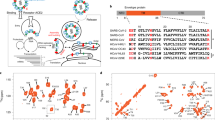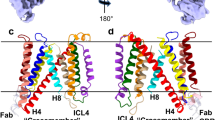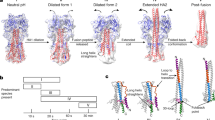Abstract
The integral membrane protein M2 of influenza virus forms pH-gated proton channels in the viral lipid envelope1. The low pH of an endosome activates the M2 channel before haemagglutinin-mediated fusion. Conductance of protons acidifies the viral interior and thereby facilitates dissociation of the matrix protein from the viral nucleoproteins—a required process for unpacking of the viral genome2. In addition to its role in release of viral nucleoproteins, M2 in the trans-Golgi network (TGN) membrane prevents premature conformational rearrangement of newly synthesized haemagglutinin during transport to the cell surface by equilibrating the pH of the TGN with that of the host cell cytoplasm3. Inhibiting the proton conductance of M2 using the anti-viral drug amantadine or rimantadine inhibits viral replication4,5,6,7. Here we present the structure of the tetrameric M2 channel in complex with rimantadine, determined by NMR. In the closed state, four tightly packed transmembrane helices define a narrow channel, in which a ‘tryptophan gate’ is locked by intermolecular interactions with aspartic acid. A carboxy-terminal, amphipathic helix oriented nearly perpendicular to the transmembrane helix forms an inward-facing base. Lowering the pH destabilizes the transmembrane helical packing and unlocks the gate, admitting water to conduct protons, whereas the C-terminal base remains intact, preventing dissociation of the tetramer. Rimantadine binds at four equivalent sites near the gate on the lipid-facing side of the channel and stabilizes the closed conformation of the pore. Drug-resistance mutations are predicted to counter the effect of drug binding by either increasing the hydrophilicity of the pore or weakening helix–helix packing, thus facilitating channel opening.
This is a preview of subscription content, access via your institution
Access options
Subscribe to this journal
Receive 51 print issues and online access
$199.00 per year
only $3.90 per issue
Buy this article
- Purchase on Springer Link
- Instant access to full article PDF
Prices may be subject to local taxes which are calculated during checkout




Similar content being viewed by others
References
Lamb, R. A., Holsinger, L. J. & Pinto, L. H. Receptor-Mediated Virus Entry into Cells (ed., Wimmer, E.) 303–321 (Cold Spring Harbor Laboratory Press, Cold Spring Harbor, 1994)
Helenius, A. Unpacking the incoming influenza-virus. Cell 69, 577–578 (1992)
Ciampor, F. et al. Evidence that the amantadine-induced, M2-mediated conversion of influenza A virus hemagglutinin to the low pH conformation occurs in an acidic trans Golgi compartment. Virology 188, 14–24 (1992)
Hay, A. J., Wolstenholme, A. J., Skehel, J. J. & Smith, M. H. The molecular basis of the specific anti-influenza action of amantadine. EMBO J. 4, 3021–3024 (1985)
Wang, C., Takeuchi, K., Pinto, L. H. & Lamb, R. A. Ion channel activity of influenza A virus M2 protein: characterization of the amantadine block. J. Virol. 67, 5585–5594 (1993)
Pinto, L. H., Holsinger, L. J. & Lamb, R. A. Influenza virus M2 protein has ion channel activity. Cell 69, 517–528 (1992)
Chizhmakov, I. V. et al. Selective proton permeability and pH regulation of the influenza virus M2 channel expressed in mouse erythroleukaemia cells. J. Physiol. (Lond.) 494, 329–336 (1996)
Sugrue, R. J. & Hay, A. J. Structural characteristics of the M2 protein of influenza A viruses: evidence that it forms a tetrameric channel. Virology 180, 617–624 (1991)
Holsinger, L. J. & Lamb, R. A. Influenza virus M2 integral membrane protein is a homotetramer Stabilized by formation of disulfide bonds. Virology 183, 32–43 (1991)
Tang, Y., Zaitseva, F., Lamb, R. A. & Pinto, L. H. The gate of the influenza virus M2 proton channel is formed by a single tryptophan residue. J. Biol. Chem. 277, 39880–39886 (2002)
Pinto, L. H. et al. A functionally defined model for the M2 proton channel of influenza A virus suggests a mechanism for its ion selectivity. Proc. Natl Acad. Sci. USA 94, 11301–11306 (1997)
Wang, J. F., Kim, S., Kovacs, F. & Cross, T. A. Structure of the transmembrane region of the M2 protein H+ channel. Protein Sci. 10, 2241–2250 (2001)
Kukol, A., Adams, P. D., Rice, L. M., Brunger, A. T. & Arkin, I. T. Experimentally based orientational refinement of membrane protein models: A structure for the influenza A M2 H+ channel. J. Mol. Biol. 286, 951–962 (1999)
Betakova, T., Ciampor, F. & Hay, A. J. Influence of residue 44 on the activity of the M2 proton channel of influenza A virus. J. Gen. Virol. 86, 181–184 (2005)
Sugrue, R. J., Belshe, R. B. & Hay, A. J. Palmitoylation of the influenza A virus M2 protein. Virology 179, 51–56 (1990)
Aldrich, P. E. et al. Antiviral agents. 2. Structure–activity relationships of compounds related to 1-adamantanamine. J. Med. Chem. 14, 535–543 (1971)
Loria, J. P., Rance, M. & Palmer, A. G. A relaxation-compensated Carr–Purcell–Meiboom–Gill sequence for characterizing chemical exchange by NMR spectroscopy. J. Am. Chem. Soc. 121, 2331–2332 (1999)
Tobler, K., Kelly, M. L., Pinto, L. H. & Lamb, R. A. Effect of cytoplasmic tail truncations on the activity of the M(2) ion channel of influenza A virus. J. Virol. 73, 9695–9701 (1999)
Pinto, L. H. & Lamb, R. A. Understanding the mechanism of action of the anti-influenza virus drug amantadine. Trends Microbiol. 3, 271 (1995)
Astrahan, P., Kass, I., Cooper, M. A. & Arkin, I. T. A novel method of resistance for influenza against a channel-blocking antiviral drug. Proteins 55, 251–257 (2004)
Subczynski, W. K., Wojas, J., Pezeshk, V. & Pezeshk, A. Partitioning and localization of spin-labeled amantadine in lipid bilayers: an EPR Study. J. Pharm. Sci. 87, 1249–1254 (1998)
Wang, J. F., Schnell, J. R. & Chou, J. J. Amantadine partition and localization in phospholipids membrane: a solution NMR study. Biochem. Biophys. Res. Commun. 324, 212–217 (2004)
Griffin, S. D. et al. The p7 protein of hepatitis C virus forms an ion channel that is blocked by the antiviral drug, Amantadine. FEBS Lett. 535, 34–38 (2003)
Plugge, B. et al. A potassium channel protein encoded by chlorella virus PBCV-1. Science 287, 1641–1644 (2000)
Svensson, T. H. Dopamine release and direct dopamine receptor activation in the central nervous system by D-145, an amantadine derivative. Eur. J. Pharmacol. 23, 232–238 (1973)
Swartz, K. J. & MacKinnon, R. Hanatoxin modifies the gating of a voltage-dependent K+ channel through multiple binding sites. Neuron 18, 665–673 (1997)
Lee, S.-Y. & MacKinnon, R. A membrane-access mechanism of ion channel inhibition by voltage sensor toxins from spider venom. Nature 430, 232–235 (2004)
Stouffer, A. L. et al. Structural basis for the function and pharmaceutical inhibition of an influenza virus proton channel. Nature doi: 10.1038/nature06528 (this issue).
Call, M. E. et al. The structure of the ζζ transmembrane dimer reveals features essential for its assembly with the T cell receptor. Cell 127, 355–368 (2006)
Chou, J. J., Baber, J. L. & Bax, A. Characterization of phospholipids mixed micelles by translational diffusion. J. Biomol. NMR 29, 299–308 (2004)
Oxenoid, K. & Chou, J. J. The structure of phospholamban pentamer reveals a channel-like architecture in membranes. Proc. Natl Acad. Sci. USA 102, 10870–10875 (2005)
Blacklow, S. C. & Kim, P. S. Protein folding and calcium binding defects arising from familial hypercholesterolemia mutations of the LDL receptor. Nature Struct. Biol. 3, 758–762 (1996)
Bax, A. et al. Measurement of homo- and heteronuclear J couplings from quantitative J correlation. Methods Enzymol. 239, 79–105 (1994)
MacKenzie, K. R., Prestegard, J. H. & Engelman, D. M. Leucine side-chain rotamers in a glycophorin A transmembrane peptide as revealed by three-bond carbon-carbon couplings and 13C chemical shifts. J. Biomol. NMR 7, 256–260 (1996)
Chou, J. J., Gaemers, S., Howder, B., Louis, J. M. & Bax, A. A simple apparatus for generating stretched polyacrylamide gels, yielding uniform alignment of proteins and detergent micelles. J. Biomol. NMR 21, 377–382 (2001)
Schwieters, C. D., Kuszewski, J., Tjandra, N. & Clore, G. M. The Xplor-NIH NMR molecular structure determination package. J. Magn. Reson. 160, 66–74 (2002)
Cornilescu, G., Delaglio, F. & Bax, A. Protein backbone angle restraints from searching a database for chemical shift and sequence homology. J. Biomol. NMR 13, 289–302 (1999)
Zweckstetter, M. & Bax, A. Prediction of sterically induced alignment in a dilute liquid crystalline phase: aid to protein structure determination by NMR. J. Am. Chem. Soc. 122, 3791–3792 (2000)
Allerhand, A. & Thiele, E. Analysis of Carr–Purcell spin-echo NMR experiments on multiple-spin systems. II. The effect of chemical exchange. J. Chem. Phys. 45, 902–916 (1966)
Acknowledgements
We thank M. Berardi for many discussions, and S. Harrison for discussion and assisting with the manuscript. This work was supported by the NIH and the Pew Scholars Program in the Biomedical Sciences awarded to J.J.C. J.R.S. is supported by an NIH F32 postdoctoral fellowship.
Author Contributions J.R.S. and J.J.C. designed research, performed research, analysed data and wrote the paper.
Author information
Authors and Affiliations
Corresponding author
Ethics declarations
Competing interests
J.J.C. and J.R.S. declare competing financial interests. A provisional patent entitled ‘Systems and Methods for Studying Influenza’ was filed on 25 October 2007 on behalf of Harvard Medical School by Wolf, Greenfield & Sacks, P.C.
Supplementary information
Supplementary Information
The file contains Supplementary Methods, Supplementary Tables S1-S2, Supplementary Figures S1-S7 with Legends and additional references. (PDF 661 kb)
Rights and permissions
About this article
Cite this article
Schnell, J., Chou, J. Structure and mechanism of the M2 proton channel of influenza A virus. Nature 451, 591–595 (2008). https://doi.org/10.1038/nature06531
Received:
Accepted:
Issue Date:
DOI: https://doi.org/10.1038/nature06531
This article is cited by
-
A structure and knowledge-based combinatorial approach to engineering universal scFv antibodies against influenza M2 protein
Journal of Biomedical Science (2023)
-
Construction of angstrom-scale ion channels with versatile pore configurations and sizes by metal-organic frameworks
Nature Communications (2023)
-
Experimental and computational studies of tautomerism pyridine carbonyl thiosemicarbazide derivatives
Structural Chemistry (2023)
-
Bioorthogonal Engineered Virus-Like Nanoparticles for Efficient Gene Therapy
Nano-Micro Letters (2023)
-
Full-length genome sequences of the first H9N2 avian influenza viruses isolated in the Northeast of Algeria
Virology Journal (2020)
Comments
By submitting a comment you agree to abide by our Terms and Community Guidelines. If you find something abusive or that does not comply with our terms or guidelines please flag it as inappropriate.



